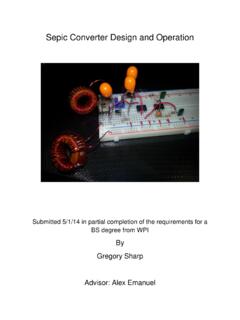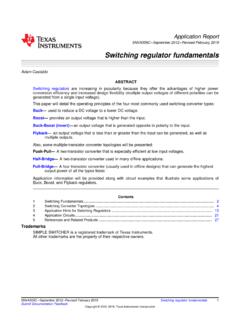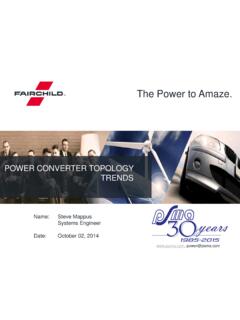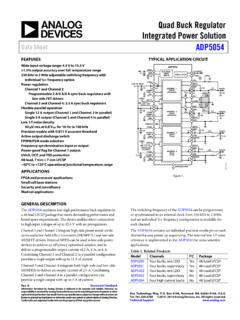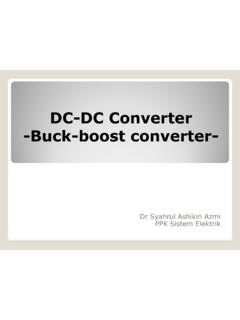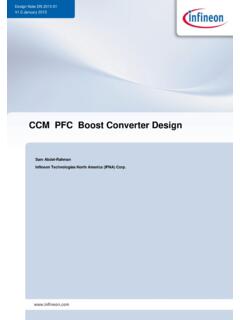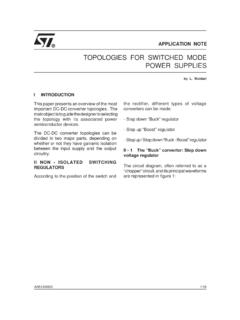Transcription of 'Magnetics Design 5 - Inductor and Flyback Transformer …
1 Section 5 Design limitations: The most important limitingfactors in Inductor Design are (a) temperature rise andefficiency considerations arising from core losses andac and dc winding losses, and (b) core filter inductors ( buck -derived) --singleand multiple windings are seldom operated in thediscontinuous current mode because of the addedburden this places on the output filter capacitor, andbecause it results in poor cross-regulation in multipleoutput supplies. Typically operated in the continuousmode with peak-peak ripple current much smallerthan full load current, ac winding loss is usually notsignificant compared to dc inductors , boost inductors and flybacktransfonners are all members of the "power Inductor "family.
2 They all function by taking energy from theelectrical circuit, storing it in a magnetic field, andsubsequently returning this energy (minus losses) tothe circuit. A Flyback transfonner is actually a multi-winding coupled Inductor , unlike the true transfonn-ers discussed in Section 4, wherein energy storage ConsiderationsDesign considerations for this family of inductorsvary widely depending on the type of circuit applica-tion and such factors as operating frequency and rip-ple applications in switching power suppliescan be defined as follows (see Fig. 5-1):.Single winding inductors :Output filter Inductor ( buck -derived)Boost inductorFlyback ( buck -boost) inductorInput filter winding inductors :Coupled output filter Inductor (R5) Flyback transformerInductor Design also depends greatly on the in- ductor current operating mode (Figure 5-2).
3 Discontinuous Inductor current mode. when theinstantaneous ampere-turns (totaled in all wind-ings) dwell at zero for a portion of each Inductor current mode. in which thetotal ampere-turns do not dwell at zero (althoughthe current may pass through zero).In the continuous current mode, the ripple currentis often small enough that ac winding loss and ac coreloss may not be significant, but in the discontinuousmode, ac losses may example, assume full load Idc of 10A, andtypical peak-peak triangular ripple current 20% of Idc,or 2A (worst at high Vin). In this example, the worst-case rms ripple current is (triangular wave-form rms equals I pp /.)
4 Jj2 ), and rms ripple currentsquared is only .333, compared with the dc currentsquared of 100. Thus, for the ac f R loss to equal thedc loss, the RajRdc ratio would have to be as large as300 (Section 3, Fig. 3-5). This is easily , ac winding loss is usually not , the small flux swing associated with smallripple current results in small core loss, with highfrequency ferrite core material operating below250kHz. Core utilization is then limited by saturation(at peak short-circuit current). However, the smallflux swing may permit the use of lossier core materi-als with higher BSAT, such as powdered iron, Kool-mu@, or laminated metal. This may enable reducedcost or size, but core loss then becomes more signifi-cant.
5 Also, distributed-gap materials exhibit roundingof the B-H characteristics (Sec. 2, pg. 2-3), resultingin decreasing inductance value as current and input filter inductors and singlewinding Flyback inductors are often designed tooperate in the continuous mode. As with the buck -derived filter inductors described previously, inductordesign is then usually limited by dc winding lossesand core , many boost and Flyback applicationsare designed to operate in the discontinuous mode,because the required inductance value is less and theinductor physical size may be smaller. But in the dis-continuous mode, the Inductor current must dwell atzero (by definition) during a portion of each switch-ing period.
6 Therefore, the peak of the triangular cur-rent waveform, and thus the peak-to-peak ripple mustbe at least twice the average current, as shown in (a). This very large ripple current results in a po-tentially serious ac winding loss problem. Also, theresulting large flux swing incurs high core loss. Coreloss then becomes the limiting factor in core utiliza-tion, rather than saturation, and may dictate a largercore size than otherwise , the circuit designer's choice of operatingmode makes a substantial difference in the inductordesign Flyback transformers are operated in thecontinuous Inductor current mode, the total ampere-turns of all the windings never dwell at zero (by defi-nition).
7 However, the current in each winding of anyflyback Transformer is always highly discontinuous,regardless of Inductor current mode. This is becausecurrent ( ampere-turns ) transfers back and forth be-tween primary and secondary(s) at the switching fre-quency. As shown in Fig. 5-3, the current in eachwinding alternates from zero to a high peak value,even though the total ampere-turns are continuouswith small ripple. This results in large ac windingloss, regardless of the operating , the core sees the total ampere-turnripple. Thus, core loss behaves in the same manner aswith the single winding Flyback Inductor discussedpreviously- small core loss when designed and oper-ated in the continuous mode, large core loss in thediscontinuous metal cores, the winding(s) should be likewisedistributed.
8 Thus, a toroidal core shape should havethe windings distributed uniformly around the a discrete gap, used with laminated metalalloy cores or ferrite cores, the winding should bedirectly over the gap. For example, if a pair of "C"core halves has a gap in one leg and the winding isplaced on the opposite (ungapped) leg, as shown inFig. 5-4a, the entire magnetic force introduced by thewinding appears across the two core halves. This re-sults in considerable stray flux propagated external tothe device, in addition to the flux through the energy stored in the external stray field can eas-ily equal the energy stored in the gap, resulting in aninductance value much greater than expected.
9 Theexternal stored energy is difficult to calculate, makingthe total inductance value unpredictable. Also, theadditional flux in the stray field will cause the in- ductor to saturate , when the same winding is placed onthe gapped core leg, as in Fig. 5-4b, the entire mag-netic force introduced by the winding is droppedacross the gap directly beneath. The magnetic forceacross the two core halves is then nearly zero, andthere is little external flux. The core then serves itsintended purpose of providing an easy (low reluc-tance) return path for the flux, requiring very littlemagnetic force to do so, and propagating very littleexternal and Temperature RiseThe discussion in Section 4 regarding tempera-ture rise limits, losses and thermal resistance in trans-formers (pp 4-1,2) is generally applicable to induc-tors, as Core and Winding LossesWhen inductors are designed for the discontinu-ous mode, with significant core loss, total loss is at abroad minimum when core and winding losses areapproximately equal.
10 But when inductors are de-signed for the continuo~s mode, core loss is oftennegligible, so that the t~talloss limit can be allocatedentirely to the Considerations --CoreIdeal magnetic materials cannot store magnetic materials store very little energy,most of which ends up as loss. In order to store andreturn energy to the circuit efficiently and with mini-mal physical size, a small non-magnetic gap is re-quired in series with a high permeability magneticcore material. In ferrite or laminated metal alloycores, the required gap is physically discrete, but inpowdered metal cores, the gap is distributed amongthe metal , virtually all of the magnetic en-ergy is stored the so-called "non-magnetic" gap(s).










